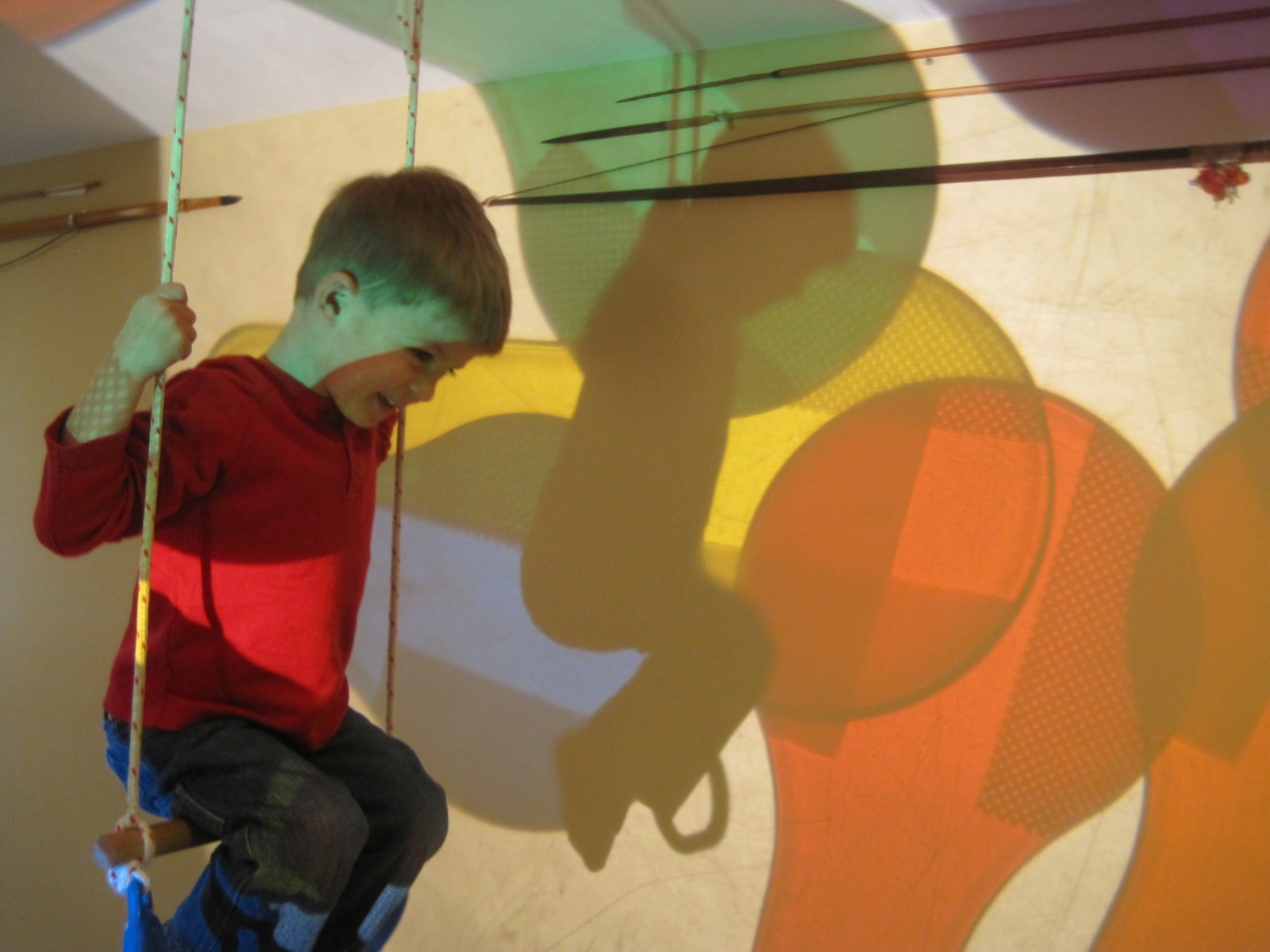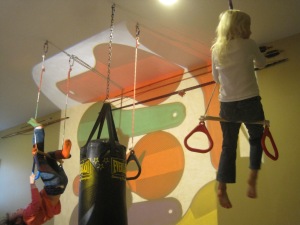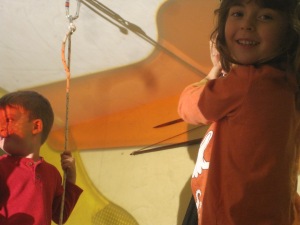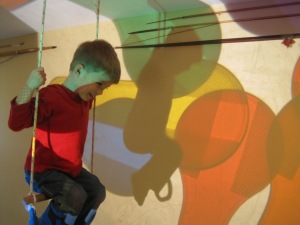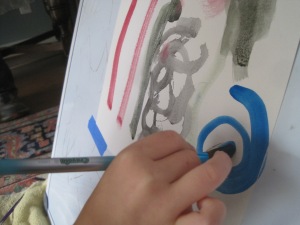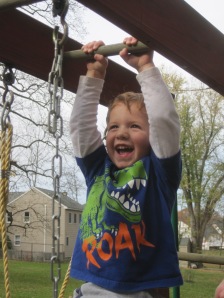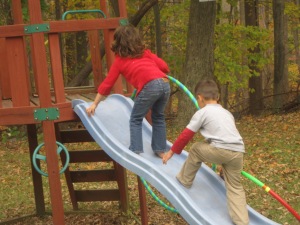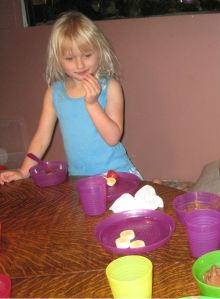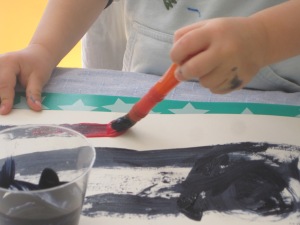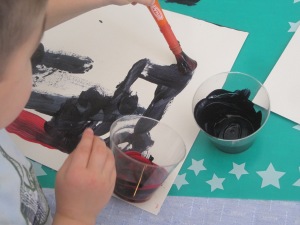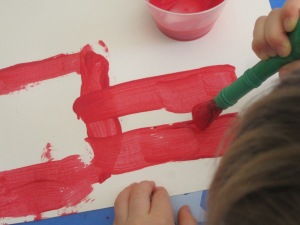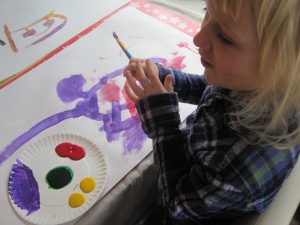When we use the color paddles on the overhead projector, we practice color mixing and color identification. If we combine this exploration with the circus rings, we also have a chance to build the muscles in our arms and legs as we flip and twist. Watching our shadows interact with the colored light on the wall helps us experiment with light and shadows, which is a way to observe cause and effect. While we play in this unstructured way together, we build vocabulary skills, practice speaking our needs and use our imaginations as we interact with our peers.
Tag Archives: color identification
A Day of Togetherness and Joy
We’ve been making paintings together at circle time as a way to practice collaborating, get some color identification work in and build strong muscles in our hands. As we do this work together each week, we develop familiarity with the tempera cakes and how to use them and we build social and vocabulary skills.
The magnet tiles continue to prove interesting. Today Rocket says as he arrives, “wow, there are so many interesting things to do today!” Later, he begins the painting below as a way to explore the construction we built together and then he notices that he can take a turn on the trampoline and hurries off. I am tempted to draw him back in and then I decide that today is probably one of the last days it will be warm enough to spend a long time outside together so I decide we’ll try again next week.
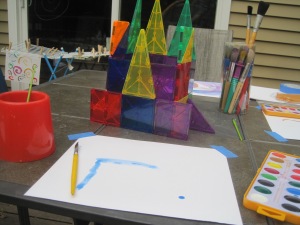
We’ve started drawing and painting our magnet tile buildings to practice making shapes, planning and making our ideas visible.
As a teacher, I say it is easy to get caught up in the chaos of the moment and forget to notice the accomplishments and sweet snippets of our days together. I got lucky this afternoon and got to watch this monkey swing like a pro across these bars and I couldn’t resist sharing his joy with you.
When we work together with our peers to make something happen as part of a dramatic play game (Anna and Elsa visit Rapunzel in her tower), we develop problem solving skills, practice engaging our friends in imaginary games, and work on peer communication skills.
Today was full of excellent learning, funny dancing, hula hoop chasing and skill building. These are just a few examples of what we’ve been up to and in observing this group today, I am reminded to not take myself so seriously, to take some deep breaths when I feel slighted by someone, to sit and eat with people that I love and that sometimes (usually?) it’s best to go with the flow instead of resisting what is happening.
The simplest of tasks
Over the last year we’ve had excellent opportunities for learning about compromise, making choices, sharing, color recognition, and negotiation…using only the dishes we eat with snack time.
There are some big feelings around which color each one of us uses and a deep desire for the cup, fork, plate and bowl to all be the same color. This is full of teachable moments!
Last week, two friends helped to set the table. The activity lasted a good fifteen minutes as they went to find each friend and find out which color they preferred to use that day. As the two friends worked to arrange a place setting for each person in our sweet group, they were doing math as they matched each object’s color. In the asking of each friend what they preferred, they were practicing communication skills.
When we sat together to eat later that day, we all had an opportunity to talk with our peers and teachers about our thoughts related to the dishes. When we have this chance to talk through what we are feeling, we work on solving social conflict and we develop interpersonal skills.
We made a plan for what we would do next week so that anyone that didn’t get the color they wanted this week would get it next week. As we did this, we practiced asking for what we want and developed the ability to treat our friends with kindness.
The simple task of setting the table was chock full of learning moments related to communication, math concepts, vocabulary and problem-solving and in the process we got to eat a delicious snack (and we only spilled half of the fruit on the floor!)
The Point of Paint
Painting may seem like a messy and inconvenient activity for many folks, local politicians certainly don’t value it for what it provides the brain or spirit and I think it’s important to make clear just exactly what your child gets out of using paint even if the finished product goes straight to the trash.
As a trained art teacher, it seems obvious to me that painting is one of the best possible ways to support a child’s muscle and brain development while touching on almost every category of learning (math, language, science, etc.). Nine years into my formal teaching career, I still find a simple painting provocation to be the most compelling to children of any age.
When a child sits with peers and paints, s/he practices:
* creative problem solving skills (How do I show the magic of this butterfly even though magic is invisible? How do I show that my sister is sleeping?)
* communicating ideas in visual form (I want to tell the story of this car that plays basketball, I want to explore what happens when I mix every color together on my paper, I want to express what I’m thinking about after watching soccer with my daddy on TV).
* color identification (one of the most often shouts heard from the painting table is-“look, I made [insert color name here]”, this is important scientific observation that many adults take for granted and many art students end up unlearning in color theory class!)
* fine motor control (different sized brushes offer varied grip practice, this is imperative for building the ability to write letters)
* sensory exploration (the texture of different paints on my hands, the sound of various brushes on paper, all of this builds the brain in valuable ways).
One of the most rewarding things I like to do while my students paint is to sit with them and copy their marks using my non-dominant hand. Inevitably, they will notice that I’m making the same kinds of marks that they are and they often offer helpful tips to help me be more successful, “that’s not how you do it, move the brush like this” or “the circle connects to the line at the bottom”. In this way, I communicate to the children that their work is valuable and that they are my teachers in how to remain open to the process of making. I use my left hand so that my marks are not well formed and my shapes a little wonky in case a child is comparing the quality of their marks to mine.
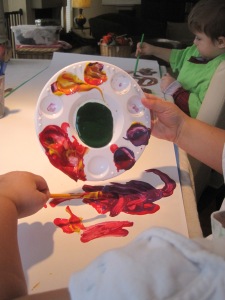
Shine demonstrates that she learned from a friend how to scoop the last of her paint onto her paper.
There are some less obvious ways that painting supports a child’s learning, and these are also important and deserve mention in this conversation about the point of paint.
When painting with peers, a child works on:
* communicating with peers (“don’t use MY paint, yours is over there”, “look what I made, it’s a beautiful butterfly”, “I’m painting this for mommy, that’s why it’s purple”)
* showing what they know about the world (“that looks like a house!”, “these are the wheels”, “a rainbow is curved like this”)
* learning by observation and then applying what s/he sees to her/his own practice
* experimenting with new tools (basting brushes, homemade brushes, bottle caps, all of these are tools that will create problems for children to solve while they are painting and allow for a scientific process of observation and experimentation to happen naturally)
* documenting the evolution of a thought process (one child’s painting may start as one thing and change as it goes, this can be disturbing for adults, while children do it very fluidly)
* asking for what they want (this relates to conversational skills and making requests instead of demands but also supports a child in finding ways to negotiate with peers/adults and recognizing/respecting limits)
* storytelling (this may happen as a child works on a picture or as s/he tells about it later)
* crossing the midline of the body (watch for this developmental milestone that is crucial to the ability to write letters like x, k and y)

Dr. Kitty experiments with what will happen when she rolls the paint brush through the paint on her paper. She says, “this is a car” as she describes the motion of the brush.
A surefire way to be disappointed as a teacher of young children is to have an inflexible idea of what the children will do while they are painting. In my opinion, the best possible way to support the children’s creative thinking and problem solving is to provide a few tools and a color or two and to watch and listen (and take tons of photographs). What they talk about while they do their work is infinitely more interesting than what I could have planned for them and points very strongly to what they are thinking about and interested in.
While they work side by side painting, their personalities show so clearly and they show me what is important to them and what they have been doing with their families. Brushes in hand, they point to who they are and what they love and leave little painty fingerprints on my life and my heart.
